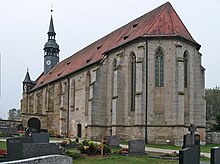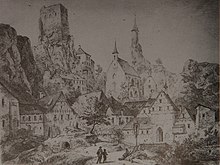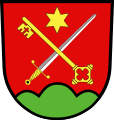Schlüsselberg (noble family)




The von Schluesselberg family was a noble Franconian aristocratic dynasty that managed to establish itself in Franconian Switzerland until it died out in 1347 and turned out to be an unpleasant competition for the bishops of Bamberg . The Schlüsselbergs founded the Schlüsselau Abbey and the town of Schlüsselfeld (1336).
origin
The ancestors of the Schlüsselberg family were first mentioned in a document in 1114. Before the construction of the new eponymous headquarters, Castle Schlüsselberg, members of the family were also called "von Greifenstein" (1172 first mention of Castle Greifenstein with "Eberhard de Grifenstein") and "von Adelsdorf" (from Adelsdorf , also Otlohesdorf, Otelsdorf).
King Heinrich V , who rebelled against his father Heinrich IV and also fought this dispute in Nordgau , rewarded the Adelsdorfers who supported him with further property around Creußen . This formed the economic basis for a further expansion of the sex in today's Forchheim district .
After the Schluesselberg Castle passed into their possession after 1216, the nobles from “Adelsdorf-Creußen-Greifenstein” called themselves “von Schlüsselberg” for the first time in 1219.
distribution
- Their sphere of influence in Franconian Switzerland included: Altendorf , Betzenstein , Burggrub , Buttenheim , Ebermannstadt , Muggendorf , Pretzfeld , Reifenberg , Schlüsselau Abbey , Schlüsselfeld (founded in 1336 by Konrad II and made a town by Emperor Ludwig), Waischenfeld and Wiesenttal , the Castles Greifenstein , Neideck , Rabenstein , Streitberg , Schlüsselberg and Waischenfeld , in Upper Franconia Schnabelwaid , and Untersteinach , in Middle Franconia Neunhof and in Baden-Württemberg Grüningen (1322–1336), Vaihingen an der Enz and especially in Hohenhaslach (Morgengabe). In addition, coats of arms indicate connections to Swabian monasteries in Hechingen , Gutenzell-Hürbel and Obermarchtal , which were probably founded on or extended by the marriage properties of Schlüsselberger heirs.
Personalities
- Eberhard I. von Schlüsselberg († 1243), married to a Swabian countess von Eberstein , founded the Schlüsselberg family in 1216
- Eberhard II von Schlüsselberg († 1283), founder of the Schlüsselau Abbey (1280), married to Elisabeth von Hohenzollern-Nuremberg
- Konrad I von Schlüsselberg († 1308), son of Eberhard II and co-founder of the Schlüsselau Abbey
- Gottfried von Schlüsselberg († 1308), son of Eberhard II and co-founder of Kloster Schlüsselau, first married to Mechthild von Wertheim and second to Margreth von Katzenelnbogen
- Gisela von Schlüsselberg († 1308), daughter of Eberhard II and first abbess of Schlüsselau Abbey
- Ulrich von Schlüsselberg († 1322), son of Eberhard II, was elected (in double election) but not appointed Bishop of Bamberg (1318–1321), Bishop of Brixen in 1322
- Konrad II von Schlüsselberg († 1347), son of Konrad I, first married to Lukardis von Hohenzollern-Nürnberg and second married to Agnes von Württemberg , Reichssturmfähnrich from 1322 to 1336
- Elisabeth von Schlüsselberg († after 1350), daughter of Gottfried (first marriage), married to Count Konrad von Vaihingen
- Richza von Schlüsselberg († 1348), daughter of Conrad II (from his first marriage), married to Count Günther XVIII. from Schwarzburg -Wachsenburg
- Beatrice von Schlüsselberg (1364), daughter of Conrad II (from his first marriage), married to Count Ulrich VI. von Helfenstein , son of Konrad's second wife Agnes von Württemberg-Helfenstein (from his first marriage)
- Anna von Schlüsselberg († 1379), daughter of Konrad II and Lukardis, nun and from 1339 abbess of Kloster Schlüsselau
- Hildegard von Schlüsselberg, daughter of Konrad II (from second marriage), married to Eitel Friedrich von Zollern
- Sophia von Schlüsselberg († after 1360), presumed sister of Konrad II., Married to Friedrich III., The old knight , from Hohenzollern-Schalksburg , who sued the Bishop of Bamberg for inheritance claims in 1360
Elisabeth von Schlüsselberg-Vaihingen
Count Konrad von Vaihingen tried in vain on November 11, 1323 before the court in Nuremberg to enforce the claims of his wife Elisabeth, daughter of Gottfried von Schlüsselberg , against Bishop Johann von Bamberg , who had filled the office in place of her intended uncle Ulrich von Schlüsselberg .
Since the princes and the other estates did not come to a joint judgment, King Ludwig agreed with his advice that Konrad von Vaihingen's claim against the bishop and his bishopric was unjustified, "after Burgrave Friedrich von Nürnberg , Heinrich Kochmeister von Nortenberg, the court ( court) scribe Adolf and Master Hermann, pastor of Sankt Sebald in Nuremberg, had declared on their oath that the deceased Emperor Heinrich had acquitted the bishopric of Bamberg from the above-mentioned lawsuit by right court and judgment ”.
This process could have been a root of the fatal conflict of Conrad II with the neighboring bishops and the burgrave of Nuremberg in 1347.
Konrad II., The last Schlüsselberger
Konrad II von Schlüsselberg was the last male representative and thus became the most influential personality of his gender. In the battle of Gammelsdorf, and especially in the battle of Mühldorf , he won the favor of King Ludwig of Bavaria and received some privileges. He was in 1322 by King Louis the pre-riders and Reich Striker Ensign appointed and therefore to the imperial city of Grüningen (now Markgröningen ) invested (to 1336).
The feud with three powerful neighbors, the Bamberg prince-bishop Friedrich von Hohenlohe , the prince-bishop of Würzburg and the burgrave of Nuremberg , became fatal for the excommunicated and thus outlawed Conrad II: on September 14, 1347 he was defending his castle Neideck down a blide .
The winners largely divided the territory of the Schlüsselbergers, who now had no male heirs, among themselves and dined off Konrad's widow and daughters with severance payments. The dispute over Konrad's inheritance continued for many years.
Crusader to Staffelstein
Even if there does not seem to be a historical connection, there is a legend in Bad Staffelstein about a Schlüsselberg crusader from Staffelstein Castle who accidentally struck down his father after his return.
Related noble families
- Eberstein in Swabia
- Gründlach in Franconia
- Helfenstein and Württemberg in Swabia
- Hohenzollern-Hechingen in Swabia, Hohenzollern-Nuremberg in Franconia and Hohenzollern-Schalksburg in Swabia
- Leuchtenberg in Franconia
- Montfort in Swabia
- Sideline Wachsenburg of the Counts of Schwarzburg in Thuringia and Franconia
- Vaihingen in Swabia
- Wertheim in Franconia
- See also the list of noble families in Franconia
coat of arms
Some community and monastery coats of arms still remind of the Schluesselberg family and their foundations. Her coat of arms was a silver key on a red background. The decorated handle is square and pierced with a rounded cross. The key bit consists of two mirrored prongs. The key originally appeared diagonally, in the Swabian region vertically on a mountain of three, partly with a beard upwards, partly downwards.
Gottfried's tomb in Schlüsselau Abbey (copper engraving 1821)
Siebmacher's coat of arms of the noble lords of Schlüsselberg
Wolleber's Count's coat of arms: vertical key on Dreiberg
Ancestral coat of arms in the Hechingen monastery church St. Luzen
Founder's coat of arms in the monastery chronicle of the Gutenzell Imperial Abbey
Coat of arms of the Marchtal monastery and the municipality of Obermarchtal
Coat of arms of the Forchheim district
Coat of arms of Adelsdorf
Coat of arms of Ebermannstadt
Coat of arms of Wiesenttal
Coat of arms of Schlüsselfeld
Altendorf coat of arms
literature
- Rudolf Endres: Konrad von Schlüsselberg. In: Gerhard Pfeiffer (Ed.): Fränkische Lebensbilder. Volume 4. Kommissionsverlag Ferdinand Schöningh, Würzburg 1971, ( Publications of the Society for Franconian History, Series VII A. Volume 4), pp. 27-48.
- Rudolf Endres : Schlüsselberg, from. In: New German Biography (NDB). Volume 23, Duncker & Humblot, Berlin 2007, ISBN 978-3-428-11204-3 , p. 110 f. ( Digitized version ).
- Paul Oesterreicher: The Reichsherr Gottfried von Schlüsselberg. A historical outline. With the genealogical tables of the imperial lords of Schlüsselberg and von Weischenfeld . Publisher of the author. Bamberg 1821. Google
- Paul Österreicher: New contributions to the history of the former rule of the Schlüsselberg . Bamberg 1823.
- Paul Oesterreicher: History and description of the Radenzgau and the original diocese of Bamberg . Bamberg 1832. Google
- Hermann Römer : Markgröningen in the context of regional history I., prehistory and the Middle Ages . Markgröningen 1933, pp. 111-121.
- Gustav Voit, Brigitte Kaulich, Walter Rüfer: From the country in the mountains to Franconian Switzerland. A landscape is discovered . Palm and Enke, Erlangen 1992, ISBN 3-7896-0511-5 ( Franconian Switzerland - Landscape and Culture 8).
- Gustav Voit: The Schlüsselberger. History of a Frankish noble family . Nuremberg 1988.
- Voigt, Gustav; the nobility on the Obermain. The Plassenburg - Writings for local research and cultural maintenance in East Franconia, Vol. 28, Kulmbach 1969.
Individual evidence
- ↑ The title of count assigned by Siebmacher and Wolleber in 1591 is not documented and could at best come from Konrad II, who was enfeoffed with the Grüningen burgrave in 1322. Image source: David Wolleber : Chorographia Württemberg, [Schorndorf] 1591, University Library Tübingen, Mh 6.1
- ^ The von Künsberg - Part I. on art-connection.de. ( Memento from December 21, 2013 in the web archive archive.today )
- ↑ History of Greifenstein Castle on Burgen-und-Schloesser.net.
- ^ The story of Adelsdorf ( Memento from August 10, 2015 in the Internet Archive )
- ↑ a b The Counts of Leuchtenberg and Schlüsselberg on markt-schnabelwaid.de.
- ↑ Betzenstein I on herrensitze.com.
- ^ Chronicle of the city of Ebermannstadt on the website of the city of Ebermannstadt.
- ↑ http://www.fraenkische-schweiz.com/gemeinden/ebermannstadt.html
- ^ Pretzfeld - The History and Chronicle ( Memento from October 20, 2007 in the Internet Archive )
- ^ History of Oberweilersbach on the website of the administrative association Kirchehrenbach.
- ↑ key field on bamberg-guide.de.
- ^ Castle ruins Neideck, Streitberg on castles in Bavaria.
- ^ Ruins of Neideck Castle ( Memento from April 30, 2003 in the Internet Archive )
- ^ History of Streitberg on fraenkische-schweiz.bayern-online.de
- ↑ History of the community of Untersteinach on their website.
- ↑ Markgröningen ( Memento of the original from July 19, 2011 in the Internet Archive ) Info: The archive link was inserted automatically and has not yet been checked. Please check the original and archive link according to the instructions and then remove this notice.
- ↑ Probably identical to Eberhard IV. (Counting [IV.] After Greifensteiner Eberharden?). The House of Bavarian History counts him as Eberhard II. See history of Schlüsselau Abbey (HdBG)
- ↑ See also the certificate of February 16, 1350.jpg
- ^ Hermann Römer: Markgröningen in the context of regional history I., Prehistory and the Middle Ages . Markgröningen 1933, p. 113.
- ↑ Landgrave Regests online No. 11869. Regest of the Landgraves of Hesse. In: Landesgeschichtliches Informationssystem Hessen (LAGIS). According to Römer , Elisabeth was a cousin of Konrad II von Schlüsselberg, so Gottfried was not his father and Ulrich was probably his cousin. Conrad is said to have been to Vaihingen in Swabia for the first time in 1312. See Hermann Römer: Markgröningen in the context of regional history I., Prehistory and the Middle Ages . Markgröningen 1933, p. 113 (Stälin III, p. 160).
- ↑ Landgrave Regests online No. 11869. Regest of the Landgraves of Hesse. In: Landesgeschichtliches Informationssystem Hessen (LAGIS).
- ↑ Battle of Gammelsdorf at gammelsdorf.de ( Memento from September 25, 2013 in the Internet Archive )
- ↑ See Paul Oesterreicher: Der Reichsherr Gottfried von Schlüsselberg. A historical outline with the genealogical tables of the imperial lords of Schlüsselberg and von Weischenfeld . Bamberg 1821.
- ↑ Sage from Staffelsteiner Chronik
- ^ Coat of arms of the Schlüsselberger
- ↑ Siebmacher and Wolleber's coat of arms of the Counts of Schlüsselberg with a vertical key on a three-mountain can only be found in the Swabian region and could go back to Konrad II, who was awarded the office of Burgrave of Grüningen in 1322 .
- ↑ The keystones in the nave show the ancestors of the builder Eitel Friedrich IV von Hohenzollern . According to Hermann Römer, one of his forefathers had: Markgröningen in the context of regional history I., Prehistory and the Middle Ages . Markgröningen 1933, p. 113, Hildegard von Schlüsselberg, daughter of Konrad II and Anna von Württemberg, married.












